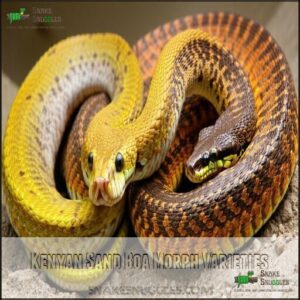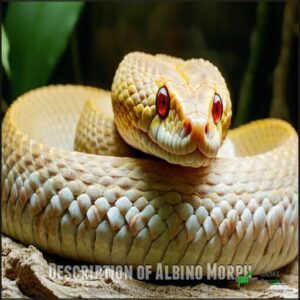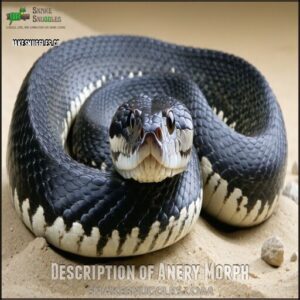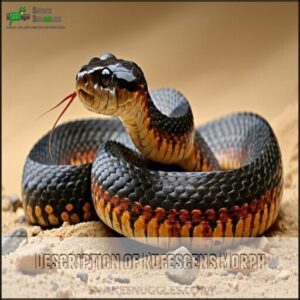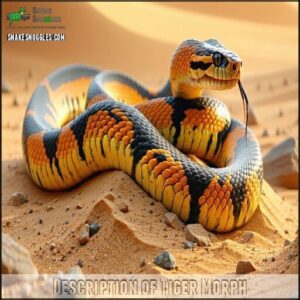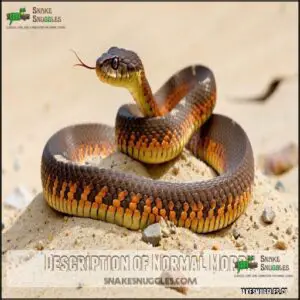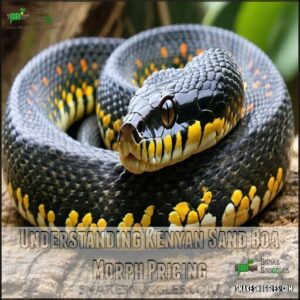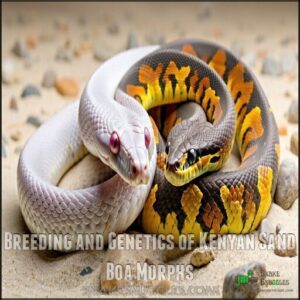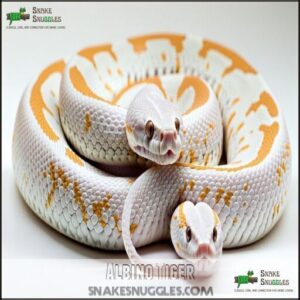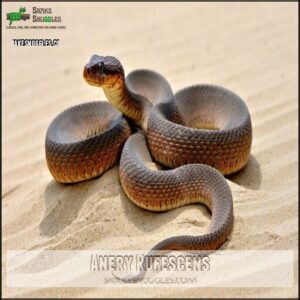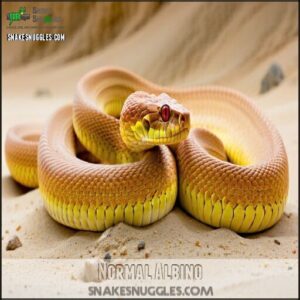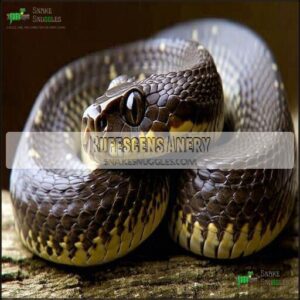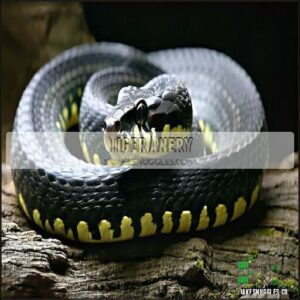This site is supported by our readers. We may earn a commission, at no cost to you, if you purchase through links.
 You’ll find Kenyan sand boa morphs in a rainbow of stunning varieties. The most popular include albinos (pinkish-cream with red eyes), anery (striking black and white), rufescens (gradient orange-brown patterns), tiger (non-striped variants), and normal (wild-type coloration).
You’ll find Kenyan sand boa morphs in a rainbow of stunning varieties. The most popular include albinos (pinkish-cream with red eyes), anery (striking black and white), rufescens (gradient orange-brown patterns), tiger (non-striped variants), and normal (wild-type coloration).
These small, manageable snakes come in specialty combinations too—like albino tiger or anery rufescens—for truly unique pets. Each morph has distinct pattern characteristics that make them stand out in any collection.
Though they share the same docile temperament, their appearance varies dramatically. The genetics behind these colorful variations is just as fascinating as the snakes themselves.
Table Of Contents
- Key Takeaways
- Kenyan Sand Boa Morph Varieties
- Characteristics of Each Kenyan Sand Boa Morph
- Understanding Kenyan Sand Boa Morph Pricing
- Breeding and Genetics of Kenyan Sand Boa Morphs
- Popular Kenyan Sand Boa Morph Combinations
- Frequently Asked Questions (FAQs)
- What does a Kenyan sand boa look like?
- What are Kenyan sand boa morphs?
- What is a reduced pattern Kenyan sand boa?
- What are splash Kenyan sand boas?
- What is a sand boa morph?
- What is a Dodoma Kenyan sand boa morph?
- How many Kenyan Sand Boa morphs are there?
- What is the most expensive sand boa morph?
- What is a rare sand boa snake?
- Do Kenyan sand boas make good pets?
- Conclusion
Key Takeaways
- You’ll find a range of stunning Kenyan sand boa morphs, including Albino, Anery, Rufescens, Tiger, and Normal, each with unique colors and patterns.
- Breeding morphs requires understanding genetics, as traits like albinism and anerythrism are recessive and need specific pairings to appear.
- Prices for Kenyan sand boas vary based on rarity, with common morphs like Albino starting around $175 and rare ones like Calico or Paradox reaching $500+.
- Kenyan sand boas are hardy, docile, and low-maintenance, making them great pets whether you’re a beginner or a seasoned snake enthusiast.
Kenyan Sand Boa Morph Varieties
You’ll find Kenyan sand boas in stunning color variations including Albino, Anerythristic, Rufescens, Tiger, and Normal morphs.
Each morph displays unique patterns and colorations, from the bright yellow-orange of Albinos to the striking brown and orange gradients of the Rufescens variety.
The variety of colors and patterns is a key aspect of what makes Kenyan sand boas appealing, with each morph offering a distinct visual experience, and the Albinos being particularly notable for their bright yellow-orange color.
Albino
The Albino Kenyan sand boa dazzles with its striking appearance, completely lacking melanin production.
This recessive trait creates a vibrant snake with yellow, orange, or cream scales instead of the typical dark markings.
- Albino appearance features crimson eyes and high-contrast patterns
- Genetic basis requires both parents to carry the albino gene
- Recessive trait makes breeding predictable for morph enthusiasts
- Albino care matches standard Kenyan sand boa husbandry needs
Average price: $175, which is a key factor for morph enthusiasts.
Anery
Anerythristic (Anery) Kenyan sand boas lack red and yellow pigmentation, creating a stunning grayscale appearance.
These morphs display smoky blacks and silvery grays instead of the warm tones seen in normal specimens.
| Trait | Description | Popular Combinations |
|---|---|---|
| Genetic Basis | Recessive trait | Anery Snow, Anery Stripe |
| Visual Identification | No red/orange pigment | Anery Paradox, Anery Ghost |
| Pattern | Dark saddles on gray | Anery Dodoma, Anery Nuclear |
You’ll find them relatively affordable and beginner-friendly.
Rufescens
The Rufescens morph showcases a distinctive dark brown body with an elegant orange blush near the belly.
This eye-catching Kenyan sand boa variant typically costs $250+ due to its moderate rarity in the morph market.
Rufescens genetics create a beautiful gradient effect between colors, making each specimen unique.
- These earthy-toned beauties will turn heads in your collection while reminding you of a desert sunset
- Their rich coloration develops more vibrantly with age, like a fine wine of the reptile world
Tiger
Sporting distinctive zigzag patterns along their bodies, Tiger Kenyan sand boas captivate collectors with their bold, eye-catching appearance.
These reptiles feature dramatic striping that replaces the typical saddle markings found in normal morphs.
| Tiger Morph Trait | Description |
|---|---|
| Pattern | Jagged stripe along spine |
| Base Color | Orange to light brown |
| Availability | Moderately common |
| Price Range | $100-200 |
| Genetic Type | Co-dominant trait |
When combined with other morphs like Albino or Snow, Tiger patterns create stunning combinations that enhance the snake’s visual appeal. These morphs breed true, making them valuable for enthusiasts looking to develop their breeding programs.
Tiger Kenyan sand boas are thus highly sought after for their unique appearance and genetic traits, offering a moderately common and affordable option for collectors and breeders alike.
Normal
While tigers showcase striking stripes, the Normal Kenyan sand boa represents the wild-type appearance that serves as the genetic baseline for all morphs.
Despite lacking fancy genetic modifications, these snakes display beautiful natural variations in their orange-brown saddle patterns.
- Prices typically range around $75, making them perfect starter snakes for new enthusiasts who want to understand morph comparisons
- Normal variations provide the foundation for identifying other morphs, with each snake showing unique wildtype coloration that slightly differs
Characteristics of Each Kenyan Sand Boa Morph
You’ll find each Kenyan sand boa morph displays unique color patterns and scale characteristics that set them apart from standard varieties.
From the bright yellow-orange of Albinos to the striking white and black of Anerys, these distinctive traits help you identify and appreciate the genetic diversity within this fascinating snake species.
Description of Albino Morph
The Albino Kenyan sand boa stands out with its striking appearance – a complete lack of melanin producing a remarkable color transformation.
You’ll notice these snakes display vibrant yellow, orange, or cream scales instead of the typical dark patterns.
This recessive trait means both parents must carry the albino gene to produce offspring with this morph.
For ideal health, consider Kenyan sand boa care guidelines.
Unlike other morphs, albinos feature distinctive ruby-red eyes and maintain their color intensity throughout their lives.
Their skin is more light-sensitive, requiring subdued lighting in their habitat.
Despite this special need, albino morphs remain popular among collectors, typically priced around $175, making them an accessible entry point for new enthusiasts.
Description of Anery Morph
The Anerythristic (Anery) Kenyan Sand Boa showcases a striking absence of red and yellow pigments, resulting in a dramatic grayscale appearance with rich blacks, crisp whites, and various gray tones.
This recessive genetic trait requires both parents to carry the anery gene for offspring to display these distinctive markings.
When examining an Anery morph, you’ll notice:
- A complete lack of orange or yellow coloration that typically appears in normal sand boas
- Sharply defined black saddle patterns against a gray or white background
- Dark eyes that contrast beautifully with their monochromatic body pattern
These visual identifiers make Anery morphs popular among collectors seeking distinctive Kenyan sand boa varieties, particularly due to their unique appearance.
Description of Rufescens Morph
With its dark brown body and orange-red belly blush, the Rufescens morph captivates snake enthusiasts seeking unique Kenyan sand boa morphs.
The dark brown Rufescens morph, with its sunset-orange belly, mesmerizes collectors seeking something truly unique.
This relatively rare variation commands prices starting around $250.
- Genetic inheritance: Rufescens carries recessive traits requiring both parents to possess the gene
- Distinctive coloration: Features a gradient shift between brown dorsal scales and orange ventral areas
- Morph rarity: Less common than Albino or Anery varieties
- Visual impact: Earthy tones create a natural, striking appearance
- Breeding complexity: Requires careful pairing to produce consistent results
Description of Tiger Morph
While the Rufescens shows earthy elegance, the Tiger morph showcases nature’s bold artistry in Kenyan sand boas.
You’ll immediately notice its distinctive striped pattern running down the spine instead of the typical saddle markings.
| Feature | Description | Appeal |
|---|---|---|
| Pattern | Bold stripe down back | Dramatic contrast |
| Colors | Orange/yellow with dark stripes | Eye-catching vibrance |
| Genetics | Recessive trait | Valuable for breeders |
| Price | $100-$175 range | Accessible collectible |
Identifying tiger morphs is simple—look for that continuous stripe pattern. When breeding tiger morphs, you’ll find they combine beautifully with other traits like albino or snow.
Description of Normal Morph
While Tiger morphs showcase bold stripes, the Normal (Wild-type) Kenyan sand boa displays nature’s original design.
These snakes feature a sandy orange base with chocolate brown saddle patterns that perfectly camouflage them in their native habitat.
- Typical coloration includes cream-colored bellies with orange sides that darken toward the back
- Standard traits include irregular dark brown blotches across the spine
- Natural patterns vary slightly between individuals, making each snake unique
- Identifying normals is easy by their consistent color variations without genetic alterations
These classic beauties represent the foundation from which all other morphs developed.
Understanding Kenyan Sand Boa Morph Pricing
You’ll find Kenyan sand boa prices vary widely from $100 for common morphs like Nuclear to $500 for rare combinations like Paradox.
The morph’s rarity, genetic makeup, and visual appeal directly affect what you’ll pay when adding one of these fascinating snakes to your collection, considering the morph’s unique characteristics.
Factors Affecting Pricing
Now that you’ve seen the stunning varieties, let’s talk money. When shopping for Kenyan sand boa morphs, several key factors influence what you’ll pay.
Rarity plays the biggest role in pricing – the less common the morph, the higher the price tag. That gorgeous Calico morph? Its scarcity makes it a premium purchase compared to captive-bred Normal varieties.
Demand fluctuates based on current trends, with striking patterns and vibrant colorations typically commanding more attention and dollars from enthusiasts. Breeder reputation substantially impacts prices too.
Established breeders with proven genetics and healthy bloodlines often charge more, but you’re paying for peace of mind. Morph combinations create unique specimens that can’t be easily replicated.
When exceptional genetics combine to create distinctive patterns, prices reflect this exclusivity. Remember, these factors interact – a rare morph from a respected breeder will always command top dollar.
Average Price Range
In the snake marketplace, Kenyan sand boa morphs come with varying price tags that fit different budgets.
Understanding the average price range helps you plan your purchase effectively. Proper Kenyan sand boa care is essential for their well-being.
Here’s a typical price comparison:
- Normal/Wild-type: $150-$200
- Albino: $175-$300
- Anery: $100-$200
- Tiger: $200-$300
- Rufescens: $250-$300
Most hobbyists find these sand boa morphs surprisingly affordable compared to other exotic reptiles.
Rarity and Demand
Within the Kenyan sand boa community, rarity directly drives demand and pricing. When you’re exploring these fascinating reptiles, you’ll notice how scarcity creates value among collectors and enthusiasts.
| Morph | Rarity Level | Average Price |
|---|---|---|
| Calico | Extremely Rare | $500+ |
| Dodoma | Very Rare | $300 |
| Rufescens | Uncommon | $250+ |
Popular morphs like Albinos ($175) remain relatively affordable, while exotic morphs like Snow and Paradox command premium prices due to limited availability.
Market trends shift constantly as breeder networks respond to collector demand. Price fluctuations follow breeding success rates—when a previously rare morph becomes more available, prices typically decrease. Conversely, newly developed or difficult-to-breed varieties often start with higher price points before stabilizing as breeding impact increases supply.
Specialty Morph Pricing
When exploring specialty Kenyan sand boa morphs, prices can vary dramatically based on rarity and demand. You can compare current sand boa morph cost online.
Premium morphs command higher prices due to breeding complexity and market trends.
- Snow morphs typically cost around $200, while rare combinations like Albino Paradox can fetch $300-$500.
Investment potential increases with exotic morphs, especially unique combinations that showcase dramatic coloration and patterns.
Breeding and Genetics of Kenyan Sand Boa Morphs
You’ll need to understand basic genetics to successfully breed Kenyan sand boa morphs, as traits like albinism and anerythrism follow specific inheritance patterns.
When you pair compatible morphs, you can produce stunning combinations like snows or paradox patterns that showcase the remarkable diversity of these fascinating snakes.
Inheritance of Morph Traits
A snake breeder’s success with Kenyan sand boa morphs depends entirely on understanding genetic inheritance patterns.
Proper Kenyan sand boa breeding requires attention to habitat, nutrition, and health.
When you’re working with these fascinating reptiles, knowing how traits pass from parents to offspring is essential.
Dominant traits show up whenever present, while recessive traits need two copies to appear.
Codominant traits, like some scale patterns, display aspects of both parent genes simultaneously.
Many sand boa characteristics follow polygenic inheritance, meaning multiple genes control a single trait’s expression.
The most exciting morph combos emerge when you map out genetic possibilities before breeding.
Some snake genetics are straightforward, but others—particularly those affecting color intensity and pattern distribution—require careful selection through multiple generations to perfect your desired morph characteristics.
Breeding Considerations
Successful breeding of Kenyan sand boas requires five essential considerations that affect both genetic outcomes and hatchling health:
- Brumation periods must match natural cycles (10-12 weeks at 65-70°F)
- Genetic pairings should avoid related bloodlines to prevent defects
- Females need to reach minimum weight (325g) before first breeding
- Incubation temps determine development speed (84-88°F is ideal)
- Breeding ethics demand prioritizing health over rare morph production
Understanding sand boa morph genetics is vital for responsible breeding. Keep detailed records of all breeding attempts.
Your female shouldn’t breed before age two. Monitor humidity during egg development. Understanding sand boa genetics helps predict offspring traits while maintaining genetic diversity.
Genetics of Various Morph Combinations
After setting up proper breeding environments, you’ll want to understand how Kenyan sand boa genetics work.
Morph inheritance follows basic Mendelian principles, with traits passing from parents to offspring in predictable patterns.
When you breed an albino with an anery, all offspring will be "het" (heterozygous) for both traits.
These combos won’t show visually until the second generation.
Some sand boa morphs, like paradox, don’t follow standard rules and appear randomly—making them genetic wildcards in your breeding program.
| Trait Type | Inheritance Pattern | Examples |
|---|---|---|
| Dominant | Need only one copy | Tiger, Nuclear |
| Recessive | Need two copies | Albino, Anery |
| Polygenic | Multiple gene pairs | Snow, Calico |
Genetic Health and Morph Expression
Genetic health directly impacts how vividly your Kenyan sand boa’s colors and patterns appear.
Vibrant colors and crisp patterns in Kenyan sand boas showcase their impeccable genetic health.
Strong gene expression produces brighter albinos and clearer pattern definition in tiger morphs.
Breeders can explore sand boa morph genetics for more information.
Watch for genetic disorders that can weaken color intensity or create uneven patterns.
Track inheritance patterns across generations to predict offspring traits.
Ethical considerations matter too—avoid closely related pairings that might introduce health issues into your sand boa’s genetic background to ensure strong gene expression.
Popular Kenyan Sand Boa Morph Combinations
You’ll find stunning visual effects when breeders combine different Kenyan sand boa morphs like Albino Tiger or Snow Paradox.
These genetic combinations create unique patterns and colors that make each snake a one-of-a-kind pet for collectors, especially those interested in unique visual effects.
Albino Tiger
After understanding the genetics behind morphs, let’s look at one of the most eye-catching combinations available today – the Albino Tiger morph.
The Albino Tiger morph combines two distinct genetic traits to create a truly spectacular snake. You’ll immediately notice its pristine white base color with striking tiger-pattern stripes that stand out dramatically against the light background.
- Genetic inheritance follows a complex pattern – albinism (recessive) paired with tiger striping (dominant)
- Rarity value keeps prices high, making these snakes a prized addition to collections
- Breeding challenges include ensuring both traits express fully in offspring
- Morph combinations like this showcase the best of selective breeding practices
- Albino Tiger appearance improves with age as patterns become more defined
These snakes fetch premium prices in the $300-500 range due to their limited availability and the specialized knowledge required to produce them consistently. Their beauty makes every penny worth it!
Anery Rufescens
While Albino Tigers showcase vibrant color patterns, the Anery Rufescens combines two distinct genetic profiles for an equally enticing display.
This rare morph pairs the anerythristic trait’s grayscale palette with the Rufescens morph’s distinctive brown-to-orange gradient shift. The result? A snake with stunning contrasts between dark saddle markings and subtle color shifts along its body.
Breeding Anery Rufescens presents some challenges, as you’ll need strong genetic lines to maintain consistent pattern quality. Their market value typically exceeds $350 due to their uncommon appearance.
Despite their unique look, these Kenyan sand boa morphs require the same care as standard varieties.
Normal Albino
While Anery Rufescens showcases darker tones, the Normal Albino combines classic wild-type patterns with stunning albino traits. You’ll immediately notice these snakes lack all black pigmentation due to their genetic basis in albinism.
Normal Albinos feature:
- Striking ruby-red eyes that appear to glow in certain lighting
- Scales in vibrant yellows, oranges, and occasional pinkish hues
- Traditional wild-type patterns without any dark pigmentation
- Excellent temperaments, making them ideal for beginners
These beautiful morphs maintain the authentic Kenyan sand boa silhouette while displaying the eye-catching coloration that’s made albinos so popular among collectors.
Rufescens Anery
When two distinctive genetic traits collide, the Rufescens Anery morph creates a spectacular visual display.
This rare combination merges the Rufescens’ dark brown body with the Anery’s absence of yellow/orange pigmentation, resulting in a unique snake with subtle color shifts.
Proper Kenyan sand boa care is essential for their health and longevity.
Both parents must carry these recessive genes for successful breeding.
Despite their rarity and higher pricing, they maintain the same docile temperament as standard Kenyan sand boa morphs, which is a key characteristic of the Kenyan sand boa.
Tiger Anery
After exploring the Rufescens Anery, let’s look at the Tiger Anery morph. This intriguing combination pairs tiger genetics with anerythristic traits, creating a striking appearance.
The Tiger Anery showcases:
- Silver-gray base coloration without red/yellow pigment
- Bold, contrasting black stripes down the spine
- Unique pattern variations from one snake to another
- Cooler visual temperature compared to standard Tiger morphs
These snakes remain relatively uncommon in the hobby, making them prized additions to breeding projects. Their dramatic appearance makes them popular despite their higher price point.
Frequently Asked Questions (FAQs)
What does a Kenyan sand boa look like?
Ever wondered what nature’s little sand-swimmers look like?
Kenyan sand boas are small, stout snakes with narrow pointed heads, small eyes, and thick bodies.
They’re typically 15-30 inches long, depending on gender.
What are Kenyan sand boa morphs?
Kenyan sand boa morphs are color and pattern variations of these snakes. You’ll find popular types like Albino, Snow, Nuclear, and Calico, with prices ranging from $100 to $500 depending on rarity.
What is a reduced pattern Kenyan sand boa?
A jaw-droppingly rare gem in the reptile world, the reduced pattern Kenyan sand boa has fewer and smaller dark markings on its body compared to standard morphs.
You’ll notice its cleaner, more minimalist appearance.
What are splash Kenyan sand boas?
Splash Kenyan sand boas are a recessive gene morph with distinctive speckled patterns.
You’ll notice they’re often combined with other morphs like albino or anery to create unique, eye-catching color combinations.
What is a sand boa morph?
You’d think a morph is a shape-shifter, but it’s actually a genetic variation that changes a snake’s appearance. Sand boa morphs display different colors and patterns from the standard wild-type.
What is a Dodoma Kenyan sand boa morph?
The Dodoma morph features distinctive circular splotches on its body, naturally occurring in an isolated population.
You’ll find these unique snakes priced around $300, making them one of the more expensive and sought-after varieties.
How many Kenyan Sand Boa morphs are there?
Like stars in the night sky, there are 10 main Kenyan Sand Boa morphs you’ll find – including Wildtype, Albino, Anerythristic, Paradox, Snow, Calico, Nuclear, Stripe, Dodoma, and Rufescens.
What is the most expensive sand boa morph?
Based on current pricing information, the Paradox morph tends to be the most expensive Kenyan Sand Boa morph, typically ranging from $300-$500 depending on its specific combination with other traits.
What is a rare sand boa snake?
The Calico sand boa stands out as one of the rarest morphs you’ll find.
It features distinctive orange, black, and white splotches across its body, creating a unique and sought-after appearance.
Do Kenyan sand boas make good pets?
As gentle as a desert breeze, Kenyan sand boas make excellent pets. They’re small, docile, low-maintenance, and don’t require much handling. Their 15-year lifespan offers you a long-term companion.
Conclusion
Scientists confirm that Kenyan sand boa morphs continue to captivate snake enthusiasts worldwide.
Whether you’re drawn to the striking albino, mysterious anery, or classic normal variety, there’s a perfect sand boa waiting for you.
Their manageable size, docile nature, and stunning patterns make them ideal pets for both beginners and experienced collectors.
As breeding techniques advance, we’ll likely see even more spectacular Kenyan sand boa morphs emerge in the coming years.
You won’t be disappointed!

